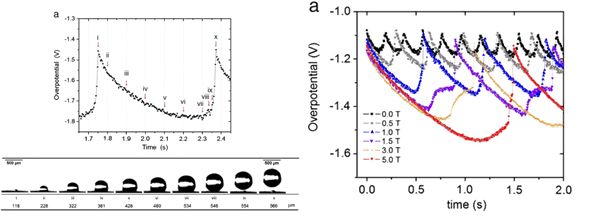Novel Magnetic Phenomena
Magnetism is based on theories of quantum mechanics and relativity devised 80 years ago, but it continues to throw up surprises. We are very interested in the magnetism of solids with no d- or f-electrons, and effects of magnetic fields in electrochemistry and biology.
d0 magnetism
This is a high-temperature phenomenon exhibited by thin films and nanoparticles of oxides that lack the d- or f-electrons normally required for ferromagnetism. We discovered the phenomenon in HfO2 thin films in 2004. The magnetization curves look ferromagnetic, but show no hysteresis. Surprisingly, the magnetism can be destroyed by dispersing the nanoparticles with an inert spacer. d0 magnetism is puzzling because the energy scale of the phenomenon is very high ~ 1000 K, the intrinsic length scale is > 100 nm, and the magnetization is very low, apparently involving only a small fraction of the sample volume. Defects are expected to play a key part in the explanation.

Examples of d0 magnetism. Magnetization curves of a 50nm of HfO2 film, exhibiting no temperature dependence (left). 4 nm CeO2 nanoparticles behave similarly, but dispersing them with 15 nm Al2O3 nanoparticles causes the magnetic moment to nearly disappear.
Magnetic water treatment
Claims that flowing hard water through a magnetic field gradient can influence the subsequent precipitation of CaCO3 up to a week later, are usually dismissed because there has been no plausible physical explanation. The recently-established presence of polymeric prenucleation clusters in equilibrium in calcium carbonate solutions provides a clue to how magnetic water treatment might possibly work.

Nucleation
Nucleation from the liquid phase is an essential first step for the growth of crystals or the evolution of gas bubbles from solution. Both processes appear to be sensitive to the presence of a uniform magnetic field, which changes the nucleation rate. A field influences the periodic growth and release of hydrogen gas bubbles produced by electrolysis of water, which can be followed by high-speed photography. The field may inhibit or enhance the bubble release, controlling the bubble size, or even destroy the periodic behaviour.

Hydrogen bubbles. Hydrogen bubble growth at a platinum microelectrode with the corresponding overpotential waveform. The panel on the right shows that a 5 T uniform magnetic field can reduce the releae frequency and double the bubble size.
Contact Mike Coey
Further Reading
[1] Magnetism in d0 oxides, J. M. D. Coey, Nature Materials 18 652-656 (2019)
[2] Magnetic water treatment, How might it work? J. M. D. Coey Philosophical Mag. (2012) 92 3857-3865 (2012)
[3] Stabilization effect of a magnetic field on a gas bubble produced at a microelectrode, Damaris Fernandez, Milena Martine, Aaron Meager, Matthias Moebius, Electrochem Comm. 18 28-32 (2012)
